|
Surrealist cultivation of dreams found its ultimate expression with Salvador Dali. In a delightfully eccentric volume, Fifty Secrets of Master Craftsmanship, Dali dispensed advice to aspiring artists. His wisdom ranged from mundane recommendations on brush types to frequency of sexual activity (advocating celibacy while awaiting inspiration but intercourse at least daily once painting--a formula B. F. Skinner would have admired). Dali claimed that the greatest potential inspiration lay in the dream.
“What you prevent yourself from doing and force yourself not to do, the dream will do with all the lucidity of desire,” he advised. Dali focused first on the sleep onset dreams or what psychologists call “hypnogogic imagery” with his technique of “Slumber with a key.” His tone was whimsical, but his intent serious as he instructed novices to sit in a comfortable armchair, “preferably Spanish”: "In this posture, you must hold a heavy key which you keep suspended, delicately pressed between the extremities of the thumb and forefinger of your left hand. Under the key you will previously have placed a plate upside down on the floor. Having made these preparations, you will have merely to let yourself be progressively invaded by a serene afternoon sleep, like the spiritual drop of anisette of your soul rising in the cube of sugar of your body. The moment the key drops from your fingers, you may be sure that the noise of its fall on the upside-down plate will awaken you. . ." Dali obtained many surreal images this way. He illustrated the essay with an example, Flesh Wheel Barrow. The twisted fibers of muscle and skin that comprised this device were arrestingly bizarre even by surrealist standards. The Master challenged his pupils with a further claim: the premium images from sleep onset were those obtained after dining on sea urchins “gathered in the last two days that precede the full moon, choosing only those whose star is coral red and discarding the yellow.” He recommended preparing them a la Catalane, in a chocolate-based sauce to which he also attributed psychoactive properties. Lest one think he was pulling the reader’s leg, sea urchins do have a reputation as a soporific among fishermen of Creus--where they are a major harvest. Our phrase “sleeping like a log” has its equivalent there in “sleeping as though you had eaten three dozen sea urchins.” One of Dali’s sketches of odd, hybrid swan-people bears the title, “Dream Provoked by a Meal of Sea Urchins.” Dali believed the elaborate night time dreams of REM sleep offered more versatile dream images because their content could be intentionally influenced. He outlined a characteristically eccentric program of nocturnal stimulation for doing so. The last dream of the night was targeted because it was “the one closest to waking” and the only one he believed was subject to influence. Recent studies conclude that, although other REM periods can be manipulated, the last one is indeed the easiest to work with. Sleep researchers apply a tactile stimulus to the skin, play recordings of distinctive noises, or shine colored lights on subjects’ closed eyes and find these may be incorporated into dream content. To generate a pleasing artistic image, Dali suggested fragrance poured near the nose, soft music, or gentle pressure on the closed eyeball--all these stimuli provided “by one’s valet.” Surrealist painters admired the new field of psychoanalysis for its emphasis on the unconscious and dreaming. Swiss artist Peter Birkhauser was a friend of Carl Jung. He found Jung’s psychology relevant to his paintings which already contained powerful dream images that Jung called “archetypes.” Birkhauser’s reading of psychoanalysis convinced him to rely on dreams even more. In “The World's Wound,” Birkhauser depicted a recurring dream of a man with a terrible, bloodless gaping split running the length of his body. The man moves beseechingly toward the dreamer, struggling to speak, but always unable. Years later, “Having Speech,” portrayed the final version of this dream. Blood flowed from the man’s wound and he was finally able to talk. Several of Birkhauser’s paintings depict death. When his wife was dying of cancer, he painted “In the Night of 13 October 1942.” In this dream his biographer wrote, "A miraculous being, half fish and half insect, climbed up beside Birkhauser's wife. . . From its mouth emanated a blue light. Courageously, Sibylle Birkhauser stood still; the fish approached her as if to kiss her and she became completely illuminated by the blue light.”8 Birkhauser’s last painting, completed just days before his own death, portrayed a dream in which a great glowing beast stood over him, inspiring both awe and terror.
•Are They or Aren’t they?•
We can’t simply note surreal qualities or read titles to tell which paintings began as dreams. René Magritte’s “Reckless Sleeper” has been used to illustrate “dream art.”
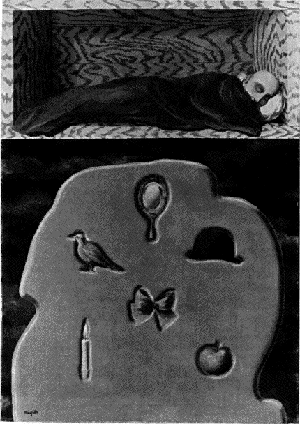
But Magritte says he never used nighttime dreams in his work and composed his paintings by an entirely rational process. Even Dali, who derived so many paintings from his “slumber with a key” and pre-awakening stimuli, titled one painting of a sleeping woman, “The Dream” which his biographers say was closely modeled on an art nouveau pin he owned in waking life. Frida Kahlo’s painting, also titled “The Dream,” is another which tempts viewers to leap nimbly to the wrong assumption. It depicts the artist, covered by vines, sleeping on a four-poster bed aloft in the sky. Above her, on the bed’s canopy, lies an eight-foot skeleton, wired ominously with explosives. When I discovered this painting, already knew that Kahlo’s work had been influenced by a horrific childhood accident.
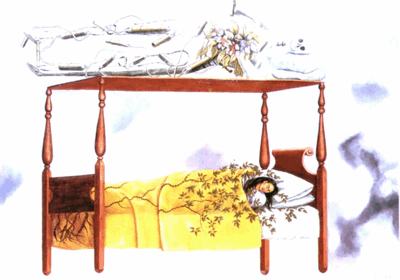
Painting in this era, Russian artist Olga Bulgakoza’s bold, fanciful images resembled Chagall’s. Her “Dream About the Red Bird” (1989) shows one man stabbing another in the back. Intermediate figures suggest they are the same man--that he ultimately kills himself. A giant red bird stands behind them. The bird’s beak and claws add just the same touch of yellow as that in the Soviet flag. The red bird casts a dark shadow over the men. We can’t know in such repressive eras whether artists are using the structure of a dream to evade censorship or if the Committee of Sleep is indeed at work. During the Soviet years, Russians did dream quite politically. At the time of the August 1991 coup, I was attending a dream conference in Moscow and our group was among the minority of Americans who remained. The morning dream sharing repeatedly involved Soviets recounting politically symbolic dreams--for example, vast numbers of people being herded helplessly like cattle--while westerners presented dreams focused on their personal lives. While dreamlike art needn’t arise from a dream, some surprisingly realistic works do. Japers Johns “Flag” is specifically classified by the art world as a prime example of the genre of “realism.” Another American painter of the same era, Elsworth Kelly, developed his abstract geometric assemblies of multiple canvases from a similar dream experience. Studying art in Paris under GI bill of rights, Kelly was not immediately inspired in any distinctive direction. When his veteran benefits ran out, he began teaching adolescents at the American School so he could remain in Paris.
One night Kelly dreamed he was working on a very large whirled splatter painting, such as his 6th graders did. Still dreaming, he had the idea of cutting up the canvas and arranging the resulting 16 pieces in a grid with their stronger lines flowing horizontally. Kelly awakened, sketched the grid, and wrote an account ending, “In this dream is something I have been waiting for.” (P. 24) His next picture was called “Brushstrokes Cut Into 20 Squares and Arranged by Chance.” Contrary to title’s “chance”, the brush strokes are horizontal as in the dream. The only change was from a 16 to 20 segment grid. Kelly repeated this grid theme for more than a year and the resulting images established his reputation and allowed him to quit teaching. One art critic observed, “What Kelly had understood through the experience of the dream and its aftermath was not just that chance could only be taken a bit at a time, but more profoundly, he understood that in order to show change, in order to make randomness visible, one had to systematize it.”
•Lucid Dreams•
Lucid dreams are those in which the dreamer realizes s/he is dreaming during the course of the dream. Consciousness allows for deliberate action. Lucid dreamers may recall plans for what to do in their dream. They carry these out even as unexpected aspects of the dream state continue to flow.
Stanford University lucidity expert Steven LaBerge devised methods to induce and shape lucid dreams. 12 LaBerge recommends asking yourself if you are dreaming during the day and making regular checks of whether your surroundings are functioning under waking laws of physics. This habit will eventually carry over into dreaming.
Can you take off and fly? Make a brick wall dissolve? Use your willpower to move that gorgeous stranger to embrace you?--Yes? Well, you’re dreaming! Can you read a long passage of text and comprehend it? Are the words still the same if you look away and then back? In the cliché of pinching yourself, is there immediate, realistic pain?--Well then, you’re probably awake.
Artists who master lucid dreaming often use it to find inspiration for their work. For the past 13 years, Painter Epic Dewfall has been doing this. "About once a month, I’ll realize I'm dreaming, and when I do, I walk around in the dream looking at art on the walls. I usually find paintings on every wall. By the time one of these lucid dreams ends, I have one or two good paintings memorized.” Dewfall says that most of the art in his lucid dreams is hanging on a wall, but that a few times he has looked through pictures in a dreamed book or even rummaged through a pile of unframed art for an image to take back to the waking world.
Most lucid dreamers wish to remain in the state and enjoy a lengthy lucid dream but sometimes, they wake up from the excitement of knowing they are dreaming. LaBerge suggests that novices are less likely to wake themselves if they avoid focusing too intently on any one object. But when artists use this state for inspiration, waking up after examining one dramatic object is actually desirable.
“A remarkably good coincidence with getting art this way,” Dewfall observes, “is that when I’ve found a painting I really like, I’ll wake up after I have been looking at it for about six seconds. I suspect this is because I’ve stopped moving from painting to painting. . . This is really more of a terrific benefit than a problem. It allows me to wake up with a very clear vision in my memory. If I were to keep lucid dreaming for another four minutes, the painting I liked so much would have disappeared from memory or at least not be so clear.”
Sculptor Penelope Jencks won the commission to cast a larger-than-life bronze statue of Eleanor Roosevelt for Riverside Park in Manhattan. The artist had always sculpted from live models. She was frustrated with her early attempts to portray the First Lady despite collecting hundreds of photos and even having a sitting with Roosevelt’s great-granddaughter, Phoebe. Then, Ms. Jencks had a dream that she was working in her studio when a voice said, “Oh, but there’s Eleanor Roosevelt.”
“Oh, my God,” Ms. Jencks thought, “I’m going to be able to use her. She’s going to pose for me. This is wonderful!”
Both a national magazine and a scholarly book presented the dream as a direct inspiration for the art. They described the event as if Ms. Jencks had instantly awoken with her artistic block broken and sculpted the statue from the dream vision.
But when I talked to the artist she said emphatically this was not the case. “No, it was a nightmare! When Eleanor Roosevelt arrived at my studio, my first thought was that this was going to be great. But then I looked up and she was huge, I only came up to her thigh. I was terrified, overwhelmed. I thought, “No way will you possibly be able to do this!”
“The thing that was so horrible was that I’d had a feeling of all these options. But I’d really bitten off more than I could chew with the technical problems. I was not quite facing up to that fact until the dream.”
So, I asked, did it help?
“No,” Jencks told me, “It stopped me cold. It was months before I began to work on the piece again. Dreams have a way of forcing me to look at reality in a manner I don’t ordinarily. But they don’t solve problems--they remind me there are problems.”
How did she eventually complete the piece? “I just gradually thought a lot about it and began to work out how I would do it.” Did the finished statue look anything like the dream character of Mrs. Roosevelt? “Well, possibly,” she said hesitantly. “In the dream she was 15 or 20 feet tall--the statue is 8 ft, but maybe just a little.” She sounded dubious that I might be trying to hang onto the romanticized version of the anecdote which I had first read. “Maybe, but it was mostly a major block, I don’t want it becoming a part of history that the dream solved it.”
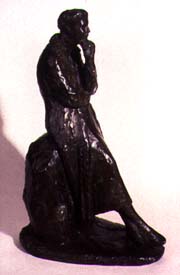
Jencks is not the only artist who has nightmares about her work. Some, however, report ones with a more salutary effect. Boston painter and sculptor Paul Laffoley describes the following dream as pivotal. “The dream began simply. I was on my way to visit an art gallery in Boston on a bright summer day. I started walking up past the Ritz Carlton without knowing how I got there but with a sense of anticipation of what I would soon see. When I came to Alpha Gallery, there was a gallery right next door called the Omega. I burst out with ‘Wow! I never noticed this gallery before. I know it doesn’t really exist but there it is.’ I thought maybe I should go in.” Artist Paul Laffoley moved up the gallery stairs with a slow ballet leap and passed through the iridescent doorway. Inside, an art opening was in progress, attended by people who were unremarkable “except better dressed than was true for receptions in Boston at that time.” But what caught Laffoley’s eye was the exhibit itself. Thirteen sculptures sat atop Ionic column pedestals. Each piece glowed brilliantly and created an illusion of depth beyond the few feet of real space it occupied. Laffoley recognized the technique for creating perspective and radiance as one he himself had previously employed. The secret was a light source sandwiched between multiple one- and two-way mirrors. These surreally dazzling sculptures utilized the lighting effect better than he or anyone had ever done. “They were “brilliant--both intellectually and visually,” he marveled. “My first reaction was complete jealousy. Now, I normally do not feel jealous when I look at other contemporary artists’ work. I may be bored, perhaps slightly interested, but not jealous. But here I was, hysterically jealous. Enraged, I stewed, ‘Everything in this show has totally wiped me out! I’ve been absorbed. All the forms I’ve been thinking about or could think about for years and years to come are expressed in this work.’” As he observed the awesome sculpture, Laffoley reported, ”I was overcome with terror. . . I knew I was trapped in the gallery and would surely die if I did not get out of this dream and out of the presence of these sculptures. That is when I did wake up screaming. My bedclothes were soaked with sweat.” For several weeks, Laffoley slept as little as possible, fearing the dream would recur. But as his anxiety abated, what had seemed a curse proved a priceless gift. “I had been shown something that I could use, from which I could learn.” The art which had overwhelmed him in the dream, supplied the designs for his next sculptures and paintings. They carried him forward into major success as an artist. “My art began then to develop into what it is today.” Long before Jencks and Laffoley, Francisco Goya sketched his frequent nightmares in his book, Los Caprichos--including its famous frontispiece, “The Sleep of Reason Begets Monsters.”
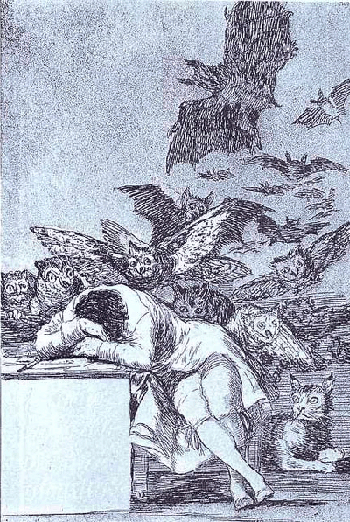
Caprichos includes images of the dreamer flying, wrestling with monsters and great birds, and scenes of sexual predation. “The Giant,” one of Goya’s major oils, depicts a goliath coming over a hillside at night.
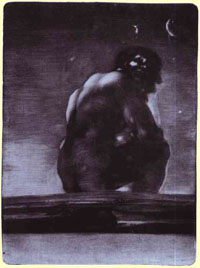
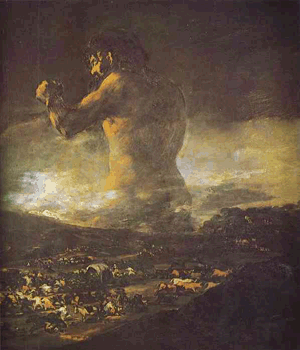
His biographers believe this work, too, was based on a nightmare. In 1819, during the worst of his recurring depressions, Goya retreated from society and created what came to be known as “The Black Paintings.” These were an attempt to defuse his nightmares by carefully documenting them. The Black Paintings are not as well-known as “The Sleep of Reason” or “The Giant” partly because they are judged to be of less artistic merit, and partly because Goya painted them not on canvas but on the walls of his house!
Architecture is a visual art, but it differs from those we’ve discussed in one important way. Almost anything a competent painter sees in a dream can be put on canvas. Architectural design involves engineering, and must operate within fixed structural limits. An artist could paint a building floating in air, or made of smoke, or whose paper walls hold up a lead roof--but one could not build it. Only a small fraction of the structures we travel through in our dreams are possible in the waking world. However architects have translated some of these into reality.
Lucy Davis, chief architect at a major North Carolina firm, describes dreaming many of her designs. In one example she told me, "The dream began with a person whose outstretched arms turned into a ship with a prow pointed at the same angle. Then it became a house I was walking through; there was a section with clerestory windows, the beams crossed and created the shape of the windows."
Davis built the house in the "Y" shape of the person's arms and boat's prow and put in the windows exactly as she had seen them in the dream. "The overall plan came from the abstract part of the dream," she says. "The window details were more literally translated." The finished house received a several-page layout in an architecture magazine.
"I've designed at least a dozen to 15 houses this way." Davis says, "It typically happens when I've worked on a project, but I'm not really getting anywhere. Those tend to be the ones that pop out in the dream process. I remember one house I was kind of stuck on and I had a dream that I went to a party in the finished house--that solved it! It was an incidental detail to the dream, but crucial to waking life."
Davis has always been an vivid dreamer. "When I was a child I remembered a lot of dreams. I had sequels--I'd continue a dream from one night to the next. When I was five, I'd have these wild cartoon dreams. As an adult I don't remember so many, but the ones I have are often connected to work."
Boston architect, Sang Kim recalls a dream from his student days which inspired one of his best designs. Most architectural projects begin with a “walk-though” of the site. But for a certain single-family housing project, Kim had merely been given information about a remote site in Georgia. “The instructor described the site as just so: lakeside, hilly, lots of trees, isolated from anything urban. Although the description of the site seemed very simple,” Kim recalls, “it’s a totally different experience once a person is in the actual site. It’s much more than just visual. Although visual is the most practical and critical element, it’s only a fraction of the full experience.
“The dream occurred at a very early stage of the project,” he told me, “I hadn’t even begun to design the actual building. During the dream, I was walking through the site (as I would do for most of my design sites). In the dream I wasn’t thinking about my design--I probably wasn't even aware of the fact that I was supposed to build something on the site. The walk-through was very real and clearly remembered. It inspired me to a particular distinctive design. If I hadn’t experienced the dream, my final design would have taken a different direction, and definitely one of much less magnitude.”
Many readers know that Samuel Taylor Coleridge dreamed his poem “Kubla Khan” in an opium-induced sleep, and we’ll discuss this more in chapter three. Less well-publicized is how the real palace of the ruler came to be constructed. Arabic history records that Khan himself dreamed the site and design of the “stately pleasure dome.” Coleridge read a description of its construction before he fell asleep, but not one that told of its dream origin--no one translated this into English until years after Coleridge’s dream. The events are eerily similar, but related only by coincidence.
Khan dreamed of a grand yet delicate palace on a sloping cliff by a deep chasm and river. He was so determined to bring this vision to life, that he sent emissaries to find a site that matched the dreamed setting. Even before they located it, he sketched the design for his builders. When the searchers spotted the appropriate hill, Khan’s domed palace was erected just as he had dreamed it.
Jungian analyst Cordy Fergus is a modern day Khan. Fergus owned a tract of wooded land in Washington state with a salmon stream running through it. He pondered what sort of house to build during the same time his analytic studies dictated that he record and sketch his dreams. One night, Fergus dreamed of Buddha-like figure seated in a lotus position meditating. “In that dream,” he says, “the person morphed into a house.” Fergus was so stuck by the image that he sketched his Buddha-house from every angle and searched out unconventional architect/builder Ray Kelly to undertake the project. Kelly improvised the three story stucco house with huge curved beams which had been discarded by conventional logging operations for their irregularities. The first floor consisted of two diagonal wings corresponding to the Buddha’s folded legs. The middle story, or the torso contained the main living area dominated by a massive fireplace constructed from smooth river stones. The third story, representing the head consisted of a domed cupola with a chakra-like skylight. Fergus, himself is an artist, inlayed the entryway with a mosaic Buddha made of pebbles and beach glass to depict the first half of his dream. This spectacular creation of the Committee was recently featured on cable television‘s Home and Garden channel.
Just as with painting, dream inspired buildings may be quite conventional and the most surreal architecture is not necessarily from dreams. Nor again, can names be relied on. The leading tourist attraction in the French province of Drome is a structure which untrained postman Ferdinand Cheval carved into a rock hillside during approximately 93,000 of his off-duty hours over 33 years. Completed in 1912, The Dream Palace winds irregularly 30 yards, studded with fantastic animals and baroque arched corridors. A jumble of styles and the influences of many cultures found their way into his creation. Years later, Picasso and Breton described the palace as the architectural expression of the surrealist movement. André Malraux, minister of culture, listed the palace as a historic monument. It has been mentioned in chapters on dream art as a dream creation and there are even quotes from Cheval translated as, “I dreamed of this palace for years before beginning it,” and “I first saw the palace in my dreams.” However, the French use the word “reve” just as we do “dream” to denote both sleeping hallucinations and daytime goals. Cheval’s longer descriptions of the palace’s design indicate it is the latter. He makes it clear that he first got the idea when looking at a misaddressed book on Moorish architecture which had been returned to his post office as undeliverable. He imagined further details and searched for an appropriate location while making his daily rounds for years before beginning construction of the “dreamlike,” but not dreamed structure.
•Other Dream Designs•
The camera, with its constraints to real life objects may not seem like a tool of The Committee. But many surrealist artists discussed as painters in this chapter or filmmakers in the next tried their hand at representing dreams in still photography. Most used either darkroom illusions such as double exposure or collage to suggest their dreamscape.
Some dreams are remarkably realistic in their imagery and are more readily captured on film. When the Director of Doubleday’s Art Department, Alex Gotfryd had a memorable dream of trailing three figures through the mist shrouded dawn streets of Venice, he hired three models and set off to capture his experience film. The resulting book of photographs, Appointment in Venice received wide acclaim.
Author Janet Baylis interviewed applied visual artists ranging from clothing designers to interior decorators and found that many of them reported dreaming solutions when they were stuck on projects. Some were directly presented the final creation such as one designer modeling a dream dress and crying “Look! Look!” as if she wanted to call the waking ego’s attention to it. Others’ dreams were abstract like the interior decorator who found herself viewing window displays that showed how each client’s personality should be expressed in differing colors and amount of lighting. The following example contained an interesting twist in the presentation of the solution:
" was asked to make a wedding dress for a girl that was pregnant. She was very cute and petite, but was beginning to ‘show.’ I had to come up with a design that would hide her condition. I tried several ideas but none of them satisfied me or her.
One morning, out of the blue, I just woke up with the idea that I instantly drew on paper and I began to work on it. I wanted to trim it with dried flowers and make a crown of the same for the headpiece. The fabric was a Georgette sheer off-white. . . . When I finished, it I was very pleased and so was the bride. That night I had this dream:
A girl with no face came to thank me for making her dress over again. She never got to wear it for her own wedding because she died before the day. She was wearing exactly the same dress in my dream and said she told me how to make it. I said, “No!” That it was my own idea, but she kept insisting she “came over” (from the other side of life) to tell me what she wanted and I just followed instructions. She even asked, “When have you ever heard of dried flowers on a dress?” She said they were fresh when she had it."
The designer came to believe she’d had a previous dream and awakened remembering only the instructions, but whether this was correct or not, it seems to have been some machination of the committee of sleep.
Southern potter Anna Marie Gundlach found over time that she could design pots by waiting to see the next one in a dream. She observed the pot’s shape and size; then that would usually be embedded with everyday objects such as nails and fabric--these she would faithfully recreate. This became so reliable a source of design that her major traveling show was titled, “Dreams in Clay.”
Although Blake dreamed about instruction in painting and Laffoley dreamed of an obscure lighting effect, these design and architectural examples stray further from the usual content of dreaming. They provide specific guidance and have a tendency to occur when the dreamer is “stuck” on a particular problem. Architecture and design can be seen as intermediate between the visual arts and other areas of creativity in the progression away from simple imagery. The disciplines in subsequent chapters call on more abstract reasoning--yet the Committee of Sleep often responds. 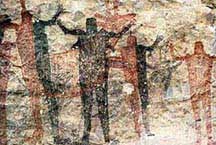
|